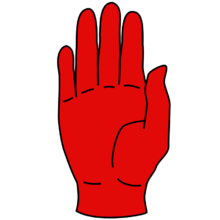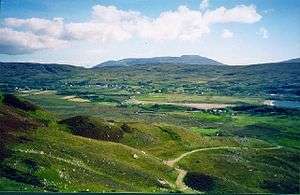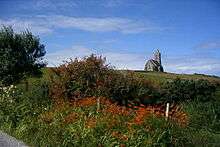Glencolmcille
| Gleann Cholm Cille | |
|---|---|
| Civil parish | |
 Gleann Cholm Cille Location in Ireland | |
| Coordinates: 54°42′32″N 8°43′34″W / 54.709°N 8.726°WCoordinates: 54°42′32″N 8°43′34″W / 54.709°N 8.726°W | |
| Country | Ireland |
| Province | Ulster |
| County | County Donegal |
| Elevation | 20 m (70 ft) |
| Population (2006) | |
| • Urban | 724 |
| Irish Grid Reference | G529846 |
| Gleann Cholm Cille is the only official name. The anglicized spellings Glencolumbkille and Glencolmcille no longer have any official status. | |
Gleann Cholm Cille (anglicized as Glencolumbkille or Glencolmcille)[1] is a coastal district in the southwest Gaeltacht of County Donegal, Ireland. It is also a civil parish in the historic barony of Banagh.[2]
While Gleann Cholm Cille is still an Irish-speaking community, English has been steadily replacing Irish as the main language, with only 34% of the people speaking Irish on a daily basis in 2002.[3] Cashel (Irish: An Caiseal) is the main village in the district.
The name translates into English as "valley of Colm Cille". Saint Colm Cille, or Columba, is one of Ireland's three patron saints (along with Saint Patrick and Saint Brigid). Colm Cille and his followers lived in the valley for a time and the ruins of several of their churches can still be seen there.

History

Between 4000 and 3000 B.C., farming people settled in the area.
The district was once famous as being the parish of Father James McDyer (1910–1987), who championed the rights of rural people and helped establish community-based industries in the area. A parish council (Comhairle Paróiste Ghleann Cholm Cille) has been functioning in Glencolumbkille since the 1930s, to look after the interests and needs of the residents of Glencolumbkille. Members are elected to this body by the residents of the Glencolumbkille church area; elections are held every three years.
Historic sites
Four sites make up National Monument #139.
Glencolumbkille Cashel
54°42′32″N 8°43′20″W / 54.708756°N 8.722247°W Penitential station, also called Glencolumbkille Turas (Irish for "journey"). Every 9 June the local people go through 15 "stations." It begins at a court cairn, constructed 3000 BC. The pilgrim circles the cairn three times praying, places his/her back to the stone, then renounce the World, the Flesh, and the Devil.[4]
Glencolumbkille Church
54°43′06″N 8°44′12″W / 54.718464°N 8.736631°W St Columbkille's holy well is located in Beefan townland.[5]
Malin Beg
54°39′54″N 8°46′14″W / 54.665009°N 8.770639°W Church of St Kevin and ringfort.
Malin More
54°40′57″N 8°43′15″W / 54.682566°N 8.720830°W Malin More is a portal tomb dated to c. 2000 BC.[6]
Culture
Glencolumbkille is home to well known Dublin-born artist Kenneth King, whose works depict naval and merchant shipping, coastline and lighthouses.[note 1]
British composer Sir Arnold Bax made many extended visits there between 1904 and the early 1930s. Apparently, Bax composed much of his music and wrote many of his poems and stories while staying there. He describes the district and its villages, and the life of its inhabitants, in his autobiography Farewell My Youth.
At one end of the little Glen Bay was a wilderness of tumbled black rocks, for some reason named Romantia (a particularly "gentle" – or fairy-haunted place, I was told in Dooey opposite), and upon this grim escarpment the breakers thundered and crashed, flinging up, as from a volcano, towering clouds of dazzling foam which would be hurled inland by the gale to put out the fires in the cottage hearths of Beefan and Garbhros. The savagery of the sea was at times nearly incredible. I have seen a continuous volume of foam sucked, as in a funnel, up the whole six-hundred-foot face of Glen Head, whilst with the wind north-west a like marvel would be visible on the opposite cliff.
There were days when you had to lean hard up against the wind to keep your feet at all... Yet in that unearthly valley there always seemed to be a core of peace in the heart of the most ravening tempest.
—Arnold Bax, Farewell My Youth
Many natural beauty sites lie nearby, such as the Slieve League (Irish: Sliabh Liag) cliffs, The Silver Strand (Irish: An Tráigh Bhán) at Malin Beg (Irish: Málainn Bhig), and Glen Head (Irish: Cionn Ghlinne) itself. Also that has been newely added is the Stone Wall just outside the village https://pbs.twimg.com/media/ClU6EccWYAA3v7t.jpg .
At the centre of one of the largest Gaeltacht areas, the district is well known as the home of Oideas Gael, an Irish-language learning institute established in 1984 to promote the Irish language and culture. The district also has a petrol station, grocer, post office, folk village (named after Father McDyer), woollen mill, hill walking and accommodation centre, restaurant, new "village cafe" and two pubs (often with Irish fiddle music).
Films shot on location in Glencolumbkille include The Railway Station Man, 1992, starring Julie Christie, Donald Sutherland and John Lynch.[7]
Dr. Charles Inglis, first Bishop of Nova Scotia
Charles Inglis was the son of a Church of Ireland rector of Glencolumbkille. After ordination, he served in New York at the down-town Trinity Church, and later had the distinction of being consecrated at Lambeth Palace as the first Bishop of Nova Scotia, and first Bishop in the British Empire overseas (1787). Bishop Inglis is remembered regularly in the Church of Ireland church at Glencolumbkille each August.
Notable people
- John Joe Doherty, Gaelic footballer
- Noel Hegarty, Gaelic footballer
- Patrick (Sonny) McGinley, novelist
Things to do
There are many things that you can do in this small village. They range from historical stories and information to learning the local Irish language and being able to see the beautiful landmarks. Oideas Gael: Learn how to speak Irish by being taught by fluent and native teachers. Many famous people have come to learn Irish such as John Finn who plays a key character in Cold Case, and the TD Joe McHugh.
GAA pitch: Come and watch or play yourself on the Naomh Columba pitch that was redone because the Gaeltacht was in Glen in 2008. There you will see people from the ages of six to late forties playing, but also you will see a large show of support when there is a game on.
Beaches: Glencolmcille has two of the most beautiful beaches. One can be located just one minute outside of the town where the waves can be big to body board or to have nice walks on the beach. The other can be located in Malin Beg where you'll have to walk 107 steps down to reach the beach 'Silver Strand'. The beach is usually a quiet beach where you are more sheltered than the one in the town. Both beaches are dog so both you and your dog can enjoy the beach.
Glencolmcille Folk Village: Here you will find dwellings that have been re created in the 18th, 19th and 20th century depicting how people used to live and their daily routines. http://www.glenfolkvillage.com/
County Wall: You are able to see a fabulous stone wall which depecits a map of Ireland, with each county being made by a native stonemason from that county. Each county is made to represent that country for example with the Donegal section it shows the red hand of Ulster to represent Donegal. It also uses the stone local to that county so it really represents the county in every way.
Fr James McDyer
Fr McDyer was born in a town about 25 minutes from Glencolmcille in a town called Glenties. He was ordained on 20th June 1937, and then moved to Glen 1951. In 1968 he had the idea to build a 'Folk Village' of different houses from different times in Ireland and to show how traditional the Irish people used to be. You start at the beginning and as you work you way through the houses you see that they start to become more modernised but very slightly. He also helped to get electricity up and running in the town and also helped to get the Errigal Fish Factory up and running which is still running and provides employment to the local people. This fish factory is a great asset to the area as it employs mostly locals and it has kept the town bustling and people in the village during the time of the recession.
Gallery
 Typical local cottage at the Folk Village Museum.
Typical local cottage at the Folk Village Museum. Folk Village Museum historical cottages.
Folk Village Museum historical cottages. Trabane Strand, Glencolumbkille.
Trabane Strand, Glencolumbkille.- Kenneth King, outside Straid Studio-Gallery
 Church of Ireland church at Glencolumbkille. Henry Musgrave had the tower built in 1913.[8]
Church of Ireland church at Glencolumbkille. Henry Musgrave had the tower built in 1913.[8]
See also
Footnotes
- ↑ Some of Kenneth King's paintings are on display in the National Maritime Museum of Ireland in Dún Laoghaire
References
- ↑ Placenames (Ceantair Ghaeltachta) Order 2004.
- ↑ "Glencolumbkille". IreAtlas Townlands Database. Retrieved 6 May 2015.
- ↑ Glencolmcille Parish Plan.
- ↑ http://www.megalithicireland.com/Glencolumbkille%20Station%2001.html
- ↑ http://www.gleanncholmcille.ie/history.htm
- ↑ http://www.megalithicireland.com/Malin%20More%20Portal%20Tombs.html
- ↑ Glencolmcille at the Internet Movie Database
- ↑ Photograph of the inscription on the church tower, Glencolumbkille
External links
- Glencolmcille website
- Glencolmcille Folk Village
- Biography of Charles Inglis at the Dictionary of Canadian Biography Online
